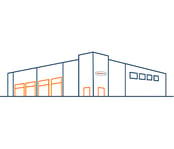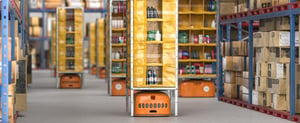Warehouse automation is changing the way businesses and brands fulfill orders for customers more efficiently and cost-effectively using new technologies.
Few organizations have the resources and knowledge to invest in warehouse automation internally. There are many solutions to consider, and no single solution should be mistaken for a silver bullet. Warehouse automation is an ongoing journey best leveraged by outsourcing logistics to a 3PL to support your goals. Automation isn’t meant to replace your labor force, but rather, to augment your resources and enable scalability.
Warehouse Automation 101
Before you can begin to envision warehouse automation in action, it’s helpful to understand what warehouse automation is—and, perhaps even more importantly, what warehouse automation is not.
Warehouse automation is a combination of software, hardware, machinery, and process that reduces manual interfacing. Automated solutions are available for virtually every aspect of the warehouse, but they must be strategically sound and integrated to be effective. Warehouse automation can reduce manual labor but is not intended to fully eliminate it. The key is for technology and warehouse workers to work together and realize the benefits of warehouse automation, such as efficiency, cost savings, accuracy, safety, and more. Read our essential guide to warehouse automation.
Warehouse Automation and Configuration
Warehouse automation works best when considered alongside warehouse configuration and the many moving parts that comprise operations. How is your warehouse currently laid out, where are the opportunities for improvement, and what solutions will make your layout more efficient? Once again, automation alone will not enhance efficiency; in fact, it could very well decrease it. It’s critical to implement automation in tune with operations. Learn more about streamlining your warehouse configuration.
Addressing Labor Shortages
Even before the pandemic, workforce shortages were impacting warehouses. Meanwhile, the rapid growth of e-commerce has led consumers to expect faster shipping and delivery. The pandemic brought both factors to a head with massive labor shortages compounded by massive demand, making automation in many ways the only solution to bridge the gap.
ODW was one step ahead with its e-commerce fulfillment center in Columbus, Ohio, which opened in 2018 to bring warehouse automation to multiple clients on a shared campus. Jeff Clark, executive vice president at ODW, said, “The challenge of an available workforce is not new, but it is having an impact on our operations. We’re looking to more automated warehouse management systems and equipment to take labor out of some of our work processes.” Read about automation to offset workforce shortages.
Automated E-Commerce Fulfillment
One of the best use cases for warehouse automation is e-commerce. As e-commerce moves fast, automation enables warehouse employees to move faster with the help of technology. When looking for an e-commerce fulfillment partner, technology is one of the top factors to consider. Sometimes, the best way to understand how that works is to see it in action. Take a video walkthrough of our Columbus fulfillment center.
Scaling Order Fulfillment
Many brands, especially those in e-commerce, have ambitions of growing and scaling. If you are one of those brands, automation is just one piece of the puzzle, but a critical one. The warehouse infrastructure required to scale starts with a warehouse management system (WMS), which provides the backbone to make automation investments. Autonomous robots and automated guided vehicles (AGVs) can be integrated with a WMS, both to reduce the labor needed and augment the workforce available. Rather than try to scale your operations on your own, look to a 3PL to be your partner in pursuing and powering your growth. Learn how to scale order fulfillment.
Enabling Cost Savings
The end goal that every business leader seeks when investing in warehouse automation is to save on labor. Cost savings should be expected, but they are not automatically granted. It takes a strategic partner and reliable provider to make warehouse automation work for your business.
To see warehouse automation in action, check out ODW’s case study on how one wine importer and distributor has been able to highly automate many of its warehouse functions and open full-time positions in other less laborious departments. Robotics auto-construct box sizes, place bottle dividers, and insert marketing materials. Voice-picking helps keep employees safer with hands-free cluster picking and improves their accuracy in barcode scanning. Box branding is also automated to support multiple carton sizes, while an automated storage tower releases orders based on assigned ship date and destination. A robotic palletizer interlocks cases in a configuration that improves pallet stability and keeps labels facing out for easy scanning. All of the above amount to 50% full-time equivalent (FTE) savings. Watch.
Considering warehouse automation for your business? Speak with an expert at ODW today.











